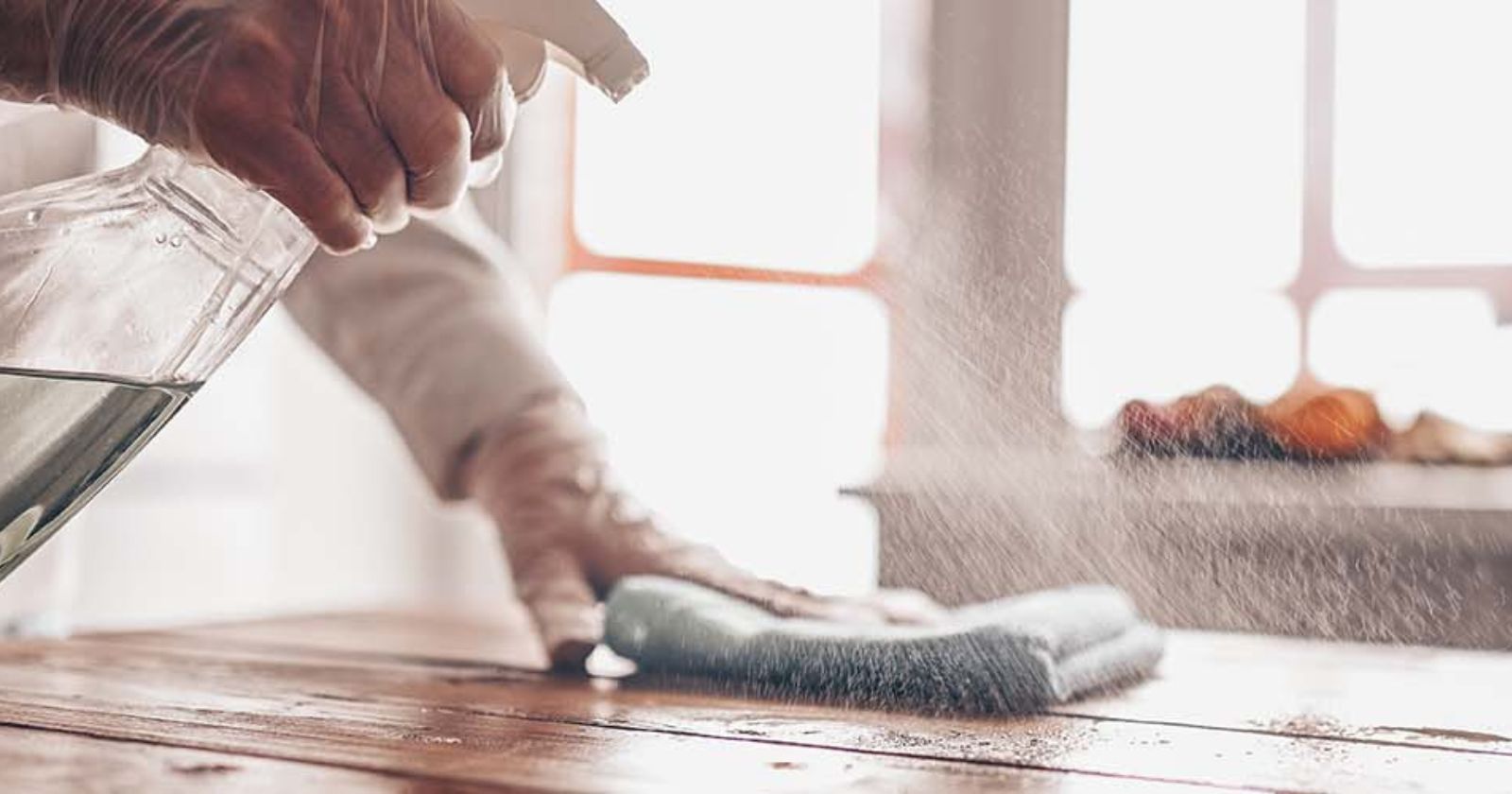Our homes are filled with wood furniture. From desks to beds, chairs to bookshelves, we’ve been using wood to furnish the home for over 10,000 years.
Unfortunately, wood furniture is highly susceptible to mold and and mildew, particularly if it’s been left in humid or damp conditions for too long. Whether you’ve been living in a house with mold problems or have purchased an antique beauty that has grown mold spores, you’ll want to get rid of the mold as soon as possible.
With a few simple solutions, many of them easily found in regular household items, you’ll be able to remove mold from wood furniture and soon have your items looking as good as new.
How to Remove Mold and Mildew From Wood Furniture
The important thing to know before you tackle the problem is what type of mold your wood furniture is growing.
If your furniture is painted, stained or varnished, then there’s a good chance that the mold or mildew is sitting on top of the wood and hasn’t yet penetrated beneath the surface. If that’s the case, then this is great news.
Either way, you shouldn’t take mold spores lightly. These tiny spores are found in the air all around a mold patch and can easily be inhaled, potentially causing a serious health hazard. So, before you tackle your mold problem, get on the safety goggles, air mask and rubber gloves.
Don’t use your nice clothes, as this is dirty work! The last thing you want is stains on your favorite jeans when you’re battling mildew.
Move the furniture to an area with good ventilation not just for your health, but to stop the mold from spreading to other pieces of furniture. If possible, take the furniture outside and tackle it there, as opposed to inside the home.
Removing Surface Mold from Wood Furniture
Wearing gloves, swipe across the mold and see if the wood underneath is still intact. If it is, then it’s likely you only have surface mildew. One way to tackle this is to get a vacuum cleaner, preferably one with a HEPA filter, and remove the mold this way.
Once you’ve done this, remove the vacuum bag outside where there’s plenty of ventilation, put it into a separate plastic bag, tie it up and dispose of it safely.
Once you’ve removed as many of the spores as possible with the vacuum cleaner, the remainder can be cleaned off with a mild solution made from dishwashing detergent mixed with some warm water. By cleaning the wood surfaces with a soft bristled brush or cloth, you should find that the mold spores lift easily.
For molds that have spread for a longer time and have taken hold a little more strongly, then the cleaning process may need to be a little more rigorous and you’ll need to apply white vinegar to the affected area.
By filling a spray bottle with white vinegar you can cover a larger surface area evenly, without concentrating too much one on spot. There’s no need to dilute the vinegar with water, as it will not cause stains on your wood.
Leave the vinegar to kill off the fungus spores on the wood surface over the following hour and once you return, wipe off again with a clean towel. It helps if the towel is slightly damp.
Go over the wood surface again, now with a dry towel, in order to catch any loose spores. Mold is a live fungus that only needs a small amount to be left behind for the whole process to begin all over again.
Removing Deep Mold from your Furniture
If you’ve tried cleaning the mold off using the dishwashing detergent and soft bristled brush approach and it’s either reappeared quickly or seems to be under the wood surface, then you’ll need to make up a stronger cleaning solution or even look at more practical methods to remove the mold.
Those rubber gloves and face mask from earlier are even more vital now! Furniture that has been sitting for long periods of time in conditions with very high moisture levels, for example extreme humidity or after flooding, may have developed black mold.
Black mold, or stachybotrys chartarum, is a toxic type of mold that appears more slimy than the powdery surface mold found in less severe cases. It often makes the furniture smell musty and damp, but don’t get too close for a sniff as you don’t want to inhale any of these potentially toxic spores.
You might think that bleach is the answer but you’d be surprised. Bleach isn’t as likely to remove mold from wood furniture as you might think. Rather than killing the mold or mildew, bleach is more likely to blanche the color of the spores so they’re less easy to spot, but still present and active.
Bleach can also end up leaving a stain on your wooden furniture without affecting mold growth, so no matter what you’ve heard, put down the bottle of bleach and look for something that’ll do a much better job.
A mold removal expert is likely to recommend a borax solution rather than bleach. Borax is a white powder found with other cleaning solutions in your local store. Use one cup of borax in a gallon of hot or very warm water, mix well and apply the solution to the affected area.
Scrub with a coarser scrub brush than the soft bristled brush from earlier. You may need to try a different scrub brush attachment if the first doesn’t work. Once you’ve tackled all the mold, don’t worry about rinsing off the borax solution as you want it to continue working even after you’ve scrubbed the wood.
Leave to air dry, preferably in the sunlight. Mold is like a vampire: it thrives in the dark and hates the sun. The UV rays help to kill mildew and mold so feel free to leave the furniture outside until dark if it’s a dry, sunny day.
What to Do When the Mold Won’t Leave!
If you’ve tried the household detergent and water solution, the vinegar in a spray bottle method, and even the borax solution and you still can’t shift the mold, then it may be in too deep.
Take some sandpaper and gently sand off the mold until you can’t see any more. Start with a finer grain of sandpaper then work up to a coarser sanding if you need to get deeper. Once you’ve finished sanding the affected area, use the vacuum to remove to remove dust, take the bag out, and dispose of it in a sealed plastic bag.
It’s still a good idea to treat the deeper wood with the borax and water solution to snuff out any chance of the mold returning. Air dry in the sun, and only when the furniture is completely dry (this may require several days) should you refinish the wood with sealant or paint to stop the mildew from returning.
If the piece of furniture is already too damaged by the mold and cleaning would make no difference, then consider having the affected area cut out altogether and replaced. If this is an antique piece of wood furniture, you will need to contact an expert restorer to do the job for you.
If all else fails, you may need to replace it. We recommend you check out our sustainable furniture guide, packed full of great eco-friendly furniture manufacturers.
How to Prevent Wood Furniture From Getting Moldy Again
Even if you’re now an expert with your vinegar spray bottle and borax water combination, it doesn’t mean you’ll be rid of mold for good. It’s always better to treat the environment as opposed to dealing with mold and mildew outbreaks.
If your home suffers from damp, take steps to rectify the problem and if you’re a renter, then approach your landlord. All the detergent products in the world are pointless if the environment is making the mildew thrive. Besides, even if your furniture remains unaffected, your health won’t.
Mildew and mold are notorious for exacerbating lung conditions and causing chronic illnesses, which is all the more reason to get on top of the issue as soon as possible.
Use air conditioning and de-humidifiers to reduce moisture in the air so that you’re not allowing any mildew to take hold. If one piece of wood furniture is affected by mold, move it away from the others so as not to cross-contaminate, and deal with it effectively.
Always clean affected wood furniture outside of the home and once you’re done, throw away all of the materials you’ve used, including any cloth, brush, air mask or glove in a sealed plastic bag.
Conclusion
There’s no reason to give up on a piece of furniture just because it’s suffering with a mildew issue. As long as you follow the steps above, use the right cleaning products for the right surfaces, and take active environmental measures to stop it recurring, you can conquer this problem for good.


